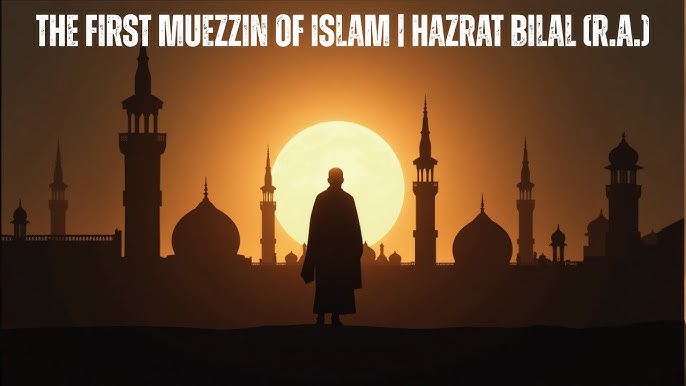Discover the inspiring story of Hazrat Bilal-e-Habshi (R.A.), the first Muazzin of Islam. Learn about his faith, struggles, slavery, freedom, and role in spreading Islam in this detailed guide. The Story of Hazrat Bilal-e-Habshi (R.A.)
When I first read about Hazrat Bilal-e-Habshi (R.A.), my heart filled with admiration. His story is one of courage, patience, and unwavering faith. Born as a slave in Makkah, he faced unimaginable hardships yet stood firm in his belief in Allah. His journey from slavery to becoming the first muazzin of Islam inspires me deeply. In this article, I will share his life, struggles, and legacy in a way that connects with our everyday lives.
Early Life of Hazrat Bilal-e-Habshi (R.A.)
Hazrat Bilal (R.A.) was born in Makkah around 580 CE. His father, Rabah, and his mother, Hamamah, were of Abyssinian origin. Because of his African heritage, he was called Bilal al-Habshi. Unfortunately, he was born into slavery and belonged to the powerful Umayyah bin Khalaf. Even though he was treated as inferior, Bilal (R.A.) always carried dignity and strength within himself, qualities that would later shine through his faith.

Acceptance of Islam
One of the most powerful parts of Hazrat Bilal’s (R.A.) life was his conversion to Islam. After listening to the message of Prophet Muhammad (PBUH), Bilal’s heart accepted the truth. He embraced Islam in its early days, knowing well that this decision would bring him suffering. Yet, his faith was so strong that he declared “Ahad, Ahad” (Allah is One). This declaration became his shield against the cruelty of his master and the Quraysh.
Persecution for Faith
The story of Hazrat Bilal (R.A.) is incomplete without understanding the severe torture he endured. His master, Umayyah, dragged him in the scorching desert of Makkah, placing heavy stones on his chest. They wanted him to renounce Islam, but his only response was “Ahad, Ahad.” This phrase still echoes in history as a symbol of resistance and faith. His strength reminds me that true belief often demands patience and sacrifice.

Freedom Through Abu Bakr (R.A.)
The suffering of Bilal (R.A.) eventually reached the ears of Hazrat Abu Bakr (R.A.), a close companion of the Prophet (PBUH). Abu Bakr could not bear to see him tortured. He purchased Bilal’s freedom, paying a high price to Umayyah bin Khalaf. With his chains broken, Bilal (R.A.) began a new life as a free man, dedicating his existence to the service of Islam. His story shows how Islam came to uplift the oppressed and honor the faithful.
The First Muazzin of Islam
One of the greatest honors given to Hazrat Bilal (R.A.) was becoming the first muazzin of Islam. The Prophet (PBUH) chose him to call the Adhan (call to prayer). His strong and melodious voice echoed through the streets of Madinah, inviting people to prayer. This role was not just a duty but also a symbol of equality, as an African former slave was chosen to hold such a noble position in Islam.

Relationship with Prophet Muhammad (PBUH)
The bond between Hazrat Bilal (R.A.) and Prophet Muhammad (PBUH) was filled with love and respect. The Prophet valued him greatly and often consoled him during difficult times. Once, the Prophet said he heard Bilal’s footsteps in Paradise, showing his high rank in Islam. This close relationship highlights how Islam removes barriers of race and status, placing true value on faith and righteousness.
His Role in Battles
Hazrat Bilal (R.A.) did not just serve as the Muazzin; he was also brave on the battlefield. He participated in major battles, including Badr, Uhud, and Khandaq. During the Battle of Badr, Bilal killed his former master, Umayyah bin Khalaf, who had tortured him. This moment symbolized justice and freedom for all oppressed Muslims. His courage inspires me to face my own struggles with strength and patience.
His Life After the Prophet (PBUH)
After the passing of Prophet Muhammad (PBUH), Hazrat Bilal (R.A.) felt immense grief. He found it difficult to give the Adhan in Madinah without the Prophet present. Later, he moved to Syria and continued his service to Islam. Even in his final days, his heart remained attached to the Prophet and the call to prayer. His life was a continuous example of loyalty, sacrifice, and love for Allah and His Messenger.

Lessons from His Life
The story of Hazrat Bilal-e-Habshi (R.A.) carries countless lessons for us today. His patience under torture teaches resilience. His role as the first muazzin teaches equality. His closeness with the Prophet teaches love and humility. Most importantly, his life reminds us that no matter our background or status, Allah values our faith, sincerity, and devotion. Every time I think of Bilal (R.A.), I feel encouraged to stand firm in my own beliefs.
Key Takeaways
| Lessons from Hazrat Bilal (R.A.) | What We Learn Today |
|---|---|
| Patience under hardship | Stay strong in tough times |
| Equality in Islam | All humans are equal before Allah |
| Freedom through faith | Faith liberates the soul |
| Devotion to Prophet (PBUH) | Love for Sunnah strengthens us |
| First Muazzin | Honor lies in serving Allah |
Famous Quote
“Ahad, Ahad (Allah is One, Allah is One).” – Hazrat Bilal (R.A.)
This powerful declaration continues to inspire generations. It shows that no force can silence the truth when faith resides in the heart.
Conclusion
Writing about Hazrat Bilal-e-Habshi (R.A.) makes me realize how deeply inspiring his story is. From slavery to becoming the first muazzin, he proved that faith can break every chain. His life stands as a beacon of courage, equality, and devotion. Whenever I hear the Adhan, I imagine Bilal’s (R.A.) voice echoing in Madinah. His journey encourages us to stay firm in faith, serve Allah sincerely, and believe that patience always leads to victory.

